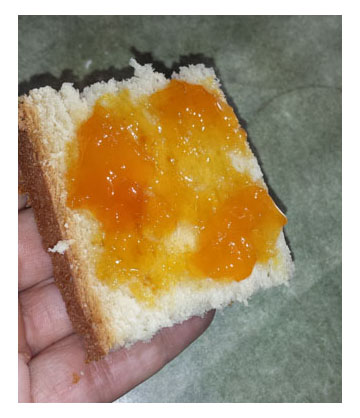It’s Peach Season
In Colorado, peach season comes in August. Back in Missouri, peaches are ready in June. But I have to say, our peaches here in Colorado are amazing – I dare say better than any southern peach. They are huge – as big as my fist – juicy, naturally super-sweet, and soft and velvety to eat. Colorado’s peaches come from the western slope (we live on the eastern side of the Rockies) from a place called Palisade. Palisade peaches are a wonder. My favorite way to eat them is to peel, pit, and slice into a bowl, sprinkle on a little powdered sugar, and drizzle with cream. I don’t have the words to describe how good this is.
Palisade peach season lasts for about three weeks, so if you’re like me, you watch for sales and buy up pounds and pounds of them and you make jam, cobblers, and slice them up for immediate eating. This past week I made a huge pot of jam, plus one cobbler for dessert. I may repeat that this coming week, before they are gone.
I’m sharing today my recipe for peach jam, as well as peach cobbler. Both are tested and work well. There are differences because we are at altitude – mainly the cooking time for the jam is much longer as our boil point is lower than sea level boiling point. I did not need to make any adjustments to the cobbler recipe. Let’s talk about that jam…
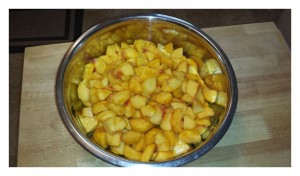 First, you need to peel a bunch of peaches. Make sure they are ripe. Don’t use green or hard peaches. You can quick-ripen peaches over a few days if you put them in a paper bag in a warm place. Plan carefully, so you’ll have what you need to make your jam. The recipe is scalable. Peel them, pit them, and cut them into chunks. The smaller the chunks, the finer the texture of the jam. I tend to do larger chunks, 3/4 inch to 1 inch, but that does mean a chunky jam. Place all of the chunks in a large glass or stainless bowl.
First, you need to peel a bunch of peaches. Make sure they are ripe. Don’t use green or hard peaches. You can quick-ripen peaches over a few days if you put them in a paper bag in a warm place. Plan carefully, so you’ll have what you need to make your jam. The recipe is scalable. Peel them, pit them, and cut them into chunks. The smaller the chunks, the finer the texture of the jam. I tend to do larger chunks, 3/4 inch to 1 inch, but that does mean a chunky jam. Place all of the chunks in a large glass or stainless bowl.
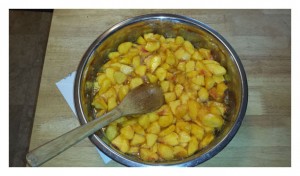 Next, add in the lemon juice and sugar. Stir to be sure all of the peaches have sugar on them. You can also add spices at this point – nutmeg or cinnamon – but I leave mine plain. I love the taste of the peaches and don’t need any extra flavor. Your kitchen will already smell amazing just from the sweet smell of the peaches. Once the sugar is mixed in, put a damp towel over the bowl and go do something else for an hour. The idea is for the peaches to macerate in the sugar. “Macerate” is a fancy word for the chemical reaction that happens when fresh fruit is put with sugar – the fruit starts to leach out its juice. This might be a good time to throw together a batch of bread in your bread machine, or mix up a loaf of beer bread. You’re going to want to taste this jam when you are done – you know, for quality control purposes.
Next, add in the lemon juice and sugar. Stir to be sure all of the peaches have sugar on them. You can also add spices at this point – nutmeg or cinnamon – but I leave mine plain. I love the taste of the peaches and don’t need any extra flavor. Your kitchen will already smell amazing just from the sweet smell of the peaches. Once the sugar is mixed in, put a damp towel over the bowl and go do something else for an hour. The idea is for the peaches to macerate in the sugar. “Macerate” is a fancy word for the chemical reaction that happens when fresh fruit is put with sugar – the fruit starts to leach out its juice. This might be a good time to throw together a batch of bread in your bread machine, or mix up a loaf of beer bread. You’re going to want to taste this jam when you are done – you know, for quality control purposes.
So, you’ve run a load of laundry or pulled some weeds in the garden or read a couple of chapters of your book, and you come back to the kitchen to find your peaches looking awesome. There is a lot of juice in the bowl. Go ahead and put that peach mixture in a big pot. And I mean BIG. I use my stainless steel stock pot, and the peach mixture doesn’t even take up a quarter of the pot. This is about the ratio you’re looking for, because once this is boiling, it is going to expand greatly. Anything that expands above 2/3 of the pot is going to get you in trouble, so think really, really big. This of course depends on how many peaches you use (see recipe for details). Turn on the heat and bring this to a boil. You can put a lid on the pot, to speed up the time, but definitely keep an eye on it so it doesn’t boil over.
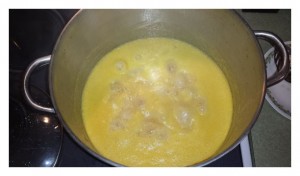 See that foam? That’s a good sign. Keep those peaches boiling. Stir them frequently, checking for scorching. If they are sticking on the bottom, you want to turn the heat down a bit and stir more frequently. Hopefully you’ve got that book handy…get comfortable next to the stove and just let that pot boil. It is going to take at least a half-hour to get even close to gel stage, which is your goal. In my high altitude environment (we are at 5,000 feet before sea level), this took almost 90 minutes. Gel stage is tricky to figure out if you’ve never done it before, but I promise you can do this. There are three ways to check for gel stage. The first way – if you have a candy thermometer, you are trying to reach 220 degrees F. Even though your pot is boiling madly, you may be surprised that you are not even at 212 (boiling point). That’s because sugar boils at a much lower temperature than water, and what you have there is a giant pot of sugar. Think about how sweet things heat up super-fast in the microwave. It’s the same thing. The second way – the spoon test. Use a cold spoon (not the one you are stirring with and dip it into the boiling mixture, then lift it up, turning it so that you see the back of the spoon and see if the juice runs off in several drips, or in a single fat drip or a sheet. You want that sheet or fat drip. The third way – drop a quarter-sized amount of juice onto a saucer and put it into the freezer for one minute. Take it out and play with that juice with your finger. If it is stiff, sticky, and feels like soft jelly, then you are good to go.
See that foam? That’s a good sign. Keep those peaches boiling. Stir them frequently, checking for scorching. If they are sticking on the bottom, you want to turn the heat down a bit and stir more frequently. Hopefully you’ve got that book handy…get comfortable next to the stove and just let that pot boil. It is going to take at least a half-hour to get even close to gel stage, which is your goal. In my high altitude environment (we are at 5,000 feet before sea level), this took almost 90 minutes. Gel stage is tricky to figure out if you’ve never done it before, but I promise you can do this. There are three ways to check for gel stage. The first way – if you have a candy thermometer, you are trying to reach 220 degrees F. Even though your pot is boiling madly, you may be surprised that you are not even at 212 (boiling point). That’s because sugar boils at a much lower temperature than water, and what you have there is a giant pot of sugar. Think about how sweet things heat up super-fast in the microwave. It’s the same thing. The second way – the spoon test. Use a cold spoon (not the one you are stirring with and dip it into the boiling mixture, then lift it up, turning it so that you see the back of the spoon and see if the juice runs off in several drips, or in a single fat drip or a sheet. You want that sheet or fat drip. The third way – drop a quarter-sized amount of juice onto a saucer and put it into the freezer for one minute. Take it out and play with that juice with your finger. If it is stiff, sticky, and feels like soft jelly, then you are good to go.
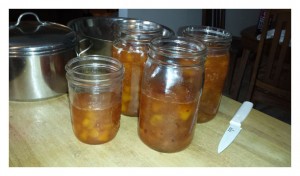 Remove the pot from the heat if you are using an electric stove. Skim off any foam, although I usually don’t have any on mine. Place jam in half-pint jars leaving 1/2 inch head space. Process in a hot water bath for 10 minutes (low altitude) or 15 minutes (high altitude). Store in the dark. Mine went into quart jars and into the freezer, because August in Colorado is hot as Satan’s bedroom, and canning is usually put off until the fall. Mine will be canned in September or early October.
Remove the pot from the heat if you are using an electric stove. Skim off any foam, although I usually don’t have any on mine. Place jam in half-pint jars leaving 1/2 inch head space. Process in a hot water bath for 10 minutes (low altitude) or 15 minutes (high altitude). Store in the dark. Mine went into quart jars and into the freezer, because August in Colorado is hot as Satan’s bedroom, and canning is usually put off until the fall. Mine will be canned in September or early October.
Enjoy!

